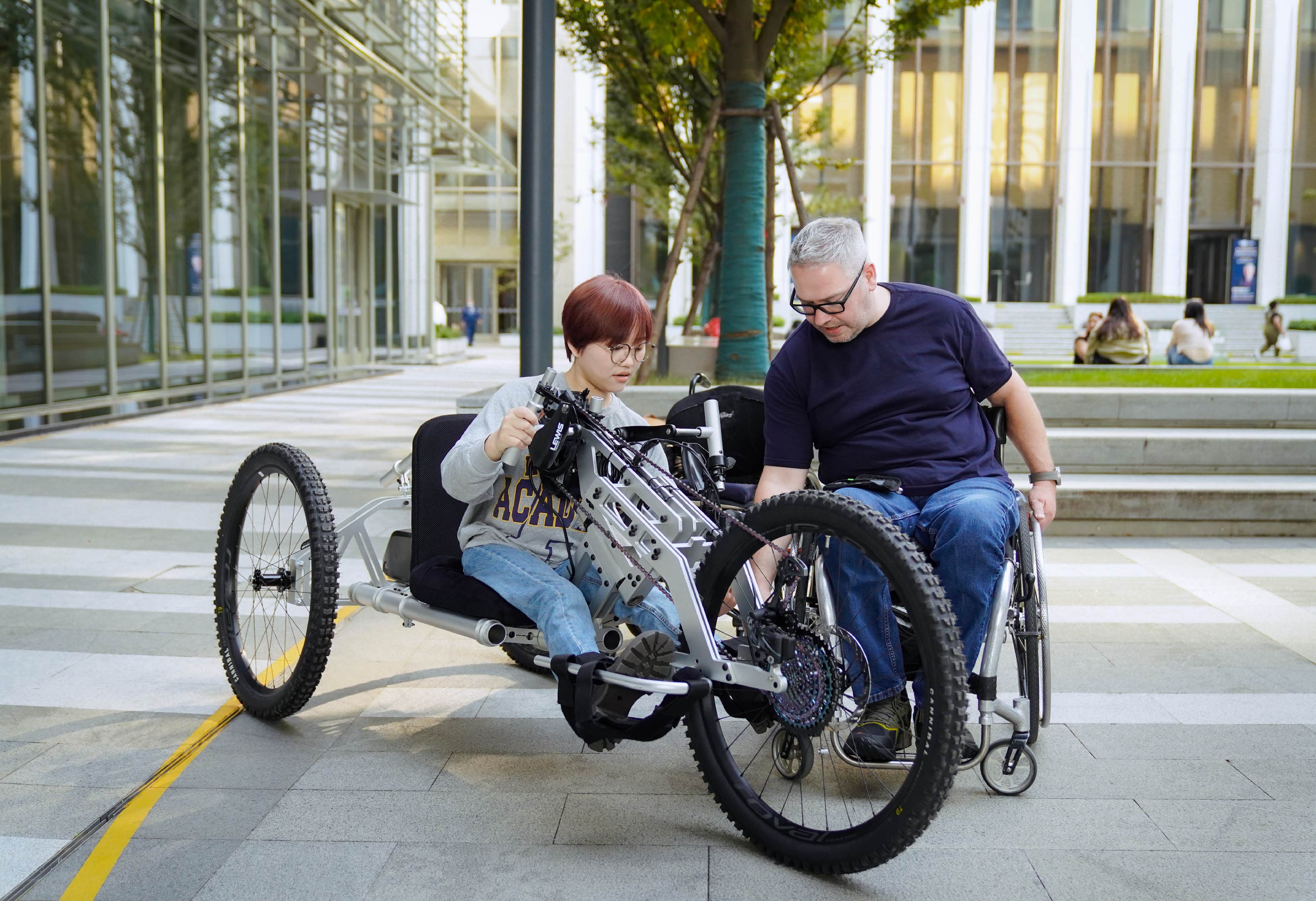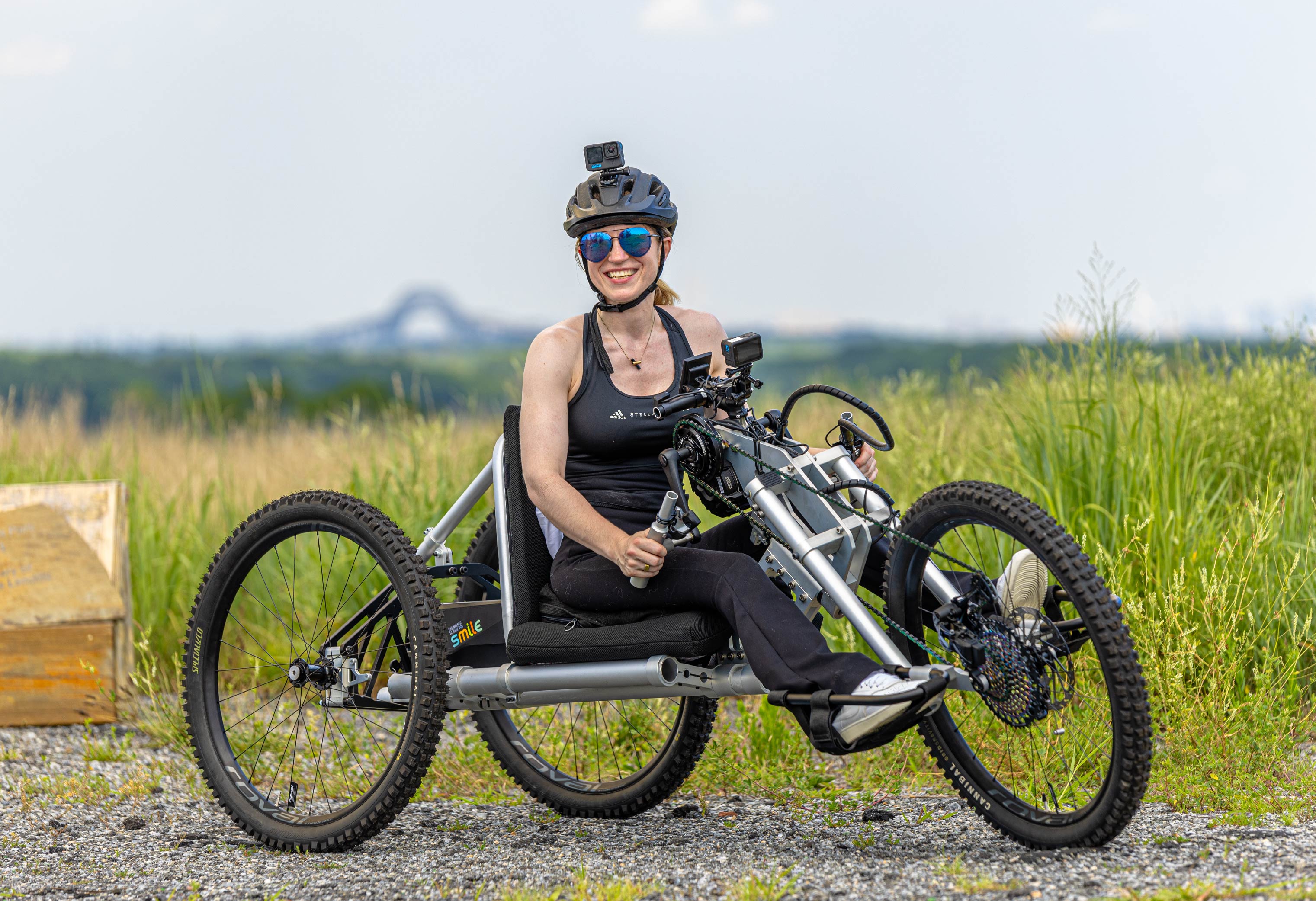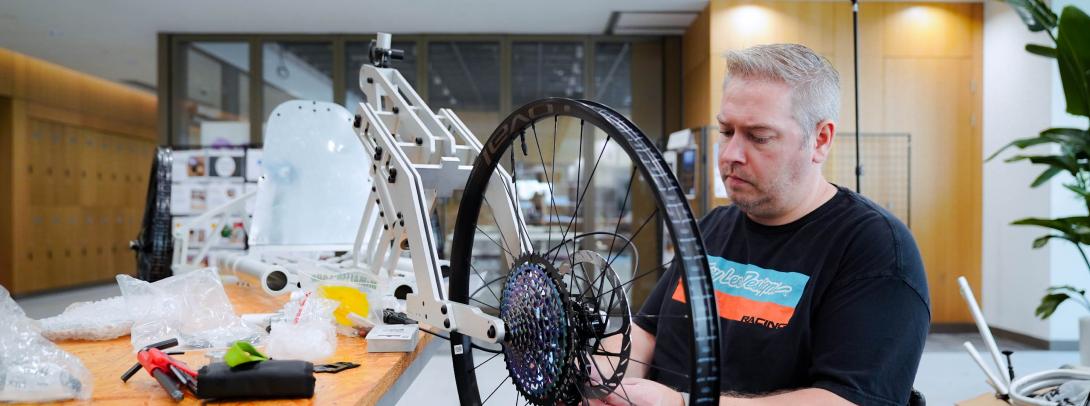Charleville Forest, with its ancient oak trees and 18th century Gothic-style castle, was teenage Noel Joyce’s stomping grounds, or rather cycling grounds. Back then, proper biking trails didn’t exist there, so he rode deep into the forest along bumpy paths made by deer. And he wouldn’t stop. Once he cycled into the Slieve Bloom Mountains, Europe’s oldest mountain range, 30 kilometers from his hometown in Tullamore, Ireland.
“I always think of the bicycle as our first carriage of freedom,” says Joyce, who became passionate about cycling when he was little. “But mountain biking in particular allows me to go to the forest and more challenging terrains, to see different things, and to be closer to nature.”

Noel Joyce assembling the mountain bike at NYU Shanghai
As a teenager, Joyce worked at a local bike shop and delved into bike mechanics. At 14 years old, a magazine cover featuring the “simple but very elegant” design of a mountain bike caught his eye, Joyce recalled. That was how his love of mountain biking started.
In his 20s, after joining the Irish military, Joyce kept riding. He represented his unit in adventure racing – mountain biking, kayaking, and forest running. “I suppose there's a little bit of the adrenaline and danger involved, which makes it really exciting,” Joyce says. He served for five years, including a six-month posting to Liberia in West Africa.
At the time, he didn’t realize that the perseverance and discipline he learned during his military stint would prove to be invaluable to him later in life, when a bike crash in 2006 left him paralyzed. He had to learn to live with a new normal as a wheelchair user, while taking care of his young family. Mountain biking was the last thing on his mind.
With his military career abruptly shortened, Joyce had to pivot. Looking for a career that could help make a difference for those with disabilities, he returned to college to study Product Design Innovation at the Institute of Technology Carlow in Ireland. Later, as the head of design at HAX, a hardware startup accelerator in Shenzhen, he worked with over 200 startups on everything from robotics to consumer products. In July 2021, he embarked on a new adventure, joining NYU Shanghai as Clinical Instructor of Interactive Media and Business (IMB), teaching Innovation Lab and Prototyping for People. Because of COVID-19 travel restrictions, he was unable to enter the country and began teaching remotely from Ireland.
It was during the pandemic, however, that he was able to reacquaint himself with his long-lost passion – mountain biking. One day, he and his neighbor decided to explore new trails built in the Slieve Bloom Mountains, the same mountains he had explored on bike as a child. 15 years after his accident, Joyce maneuvered the trails on a hand-powered bike made by a wheelchair maker.
“The same feeling when I was able-bodied, the same exhilaration, the same sense of adventure, everything that I loved about it the first time, came flowing back,” recalls Joyce. “Probably even stronger because when it's taken away, you think you’d never have it again.”
The hand bike quickly broke though. A professionally-made adaptive mountain bike would only be available after a six-month waiting period and would cost over USD 15,000. As an industrial designer and a biker, Joyce knew what features would suit his needs and make for a more comfortable biking experience for wheelchair users such as himself. He sent his ideas to various professional adaptive mountain bike makers worldwide, looking for a company that would be willing to build one from scratch for him.
A Spanish manufacturer responded and built him a custom-made mountain bike, but not too long after, he crashed it while riding in the forest. Once again, he was faced with a long waiting period and an expensive price tag.
That’s a typical problem faced by people with disabilities, Joyce says. “They don't have the same opportunity to enjoy the sport or do the things that they want to do, because their body will deteriorate faster than an able-bodied person,” he says. “And they have to wait longer and pay more to enjoy the sport.”

Da Chengzi (left), a wheelchair user in Shanghai, trying Noel Joyce’s adaptive mountain bike for the first time at NYU Shanghai’s campus
So Joyce decided to use his skills to design and build a more affordable, stronger, and more accessible adaptive mountain bike. He started the design in April 2022 while in Ireland, but had to postpone the process while he traveled to NYU to teach during the fall semester.
While at NYU, Joyce received funding through Tandon School of Engineering’s Vertically Integrated Projects (VIP), a project-based, interdisciplinary, funded research program engaging students and staff. The result was Project Mjolnir (the name references the Norse god Thor’s hammer), an open source adaptive mountain bike initiative that enables sport-loving wheelchair users to build their own adaptive bikes.
Working with Tisch School of Arts’ Makerspace Lab Manager Phil Caridi, Tandon School’s Design Lab Manager Molly Ritmiller, as well as a group of students, Joyce’s team started the design in January 2023 with the objective of building adaptive bikes across NYU’s global network of campuses in New York, Abu Dhabi, and Shanghai.
“Diversity and inclusion at NYU are important subjects,” says Joyce. “I thought this would be a great project to utilize the capabilities at all of the campuses to create an open-source adaptive mountain bike – something that didn’t exist in any of these locations before.”
Using a design software and 3D printers, the team develops mockups, which they then send to a prototype manufacturer to make the parts. Then they assemble the custom-made parts into a 3-wheel electric-assist adaptive bike about two meters long and 80 centimeters wide. The bike has several unique features. Independently operating hydraulic brakes on the wheels help the bike maneuver around tight corners. The rider controls the bike with hand pedals at the front end which can be operated manually, electrically or in hybrid mode. The bike can be customized to suit the size of the rider and their specific physical challenges. It can even be modified for seniors as a daily mobility advice as well.
Joyce and his Project Mjolnir team built their first bike in New York in the spring. When he went to teach at NYU Abu Dhabi in June, Joyce built a second bike there, which was heralded as the UAE’s first adaptive mountain bike. Over the summer, he returned home to Ireland and built a third bike with an upgraded and more cost-effective design.

Rachael Wallach, who was paralyzed due to a spinal cord injury 23 years ago, riding Noel Joyce’s bike at the trails at Staten Island’s Freshkills Park in New York in July 2023
Joyce says each iteration allows opportunities for improvements. “If you are a designer, if you think you have finished, then you're a fool,” says Joyce. “There are always opportunities to make things better. That’s what I keep telling my students.”
After arriving in Shanghai in October, Joyce built his fourth adaptive bike on the New Bund campus in under two days. The first adaptive mountain bike in China, it costs roughly USD 4000 to make, just a third of the price of a store-bought adaptive mountain bike.
Having proved that the DIY adaptive mountain bike concept works, Joyce plans to release the design file online for free so anyone can access the files and adjust the design to suit their needs. Most importantly they won’t have to wait six months, which is the typical waiting period for a new adaptive bike. During the build process, Joyce hopes people will feel empowered to learn how to put a bike together themselves and how to repair it when needed.
IMB Area Head and Associate Professor of Interactive Media and Business Alex Ruthmann says that projects like Joyce’s are an important example of research-led projects having a larger impact on local communities. “Universities, especially global universities like NYU Shanghai, can be an incubator for innovation that benefits not just our students, but the broader world, locally here in Shanghai and around the globe,” he says.
Joyce is already seeing the impact of his innovation. Da Chengzi, a local Shanghainese wheelchair user who advocates for accessibility for people with disabilities through social media, heard about Joyce’s bike and came to NYU Shanghai’s campus to give it a try. Having never ridden a bike before in her life, she was curious and excited to take it for a spin. She was noticeably a little nervous as she moved onto the bike from her wheelchair, but as Joyce made adjustments to the bike to suit Da Chengzi better, she started to feel more comfortable and began to use her hands to pedal. After pedaling her first loop around the campus quad, she went for another round. And another.
“I’m a nature person. But the lack of accessibility in most public places stops me from going anywhere,” said Da Chengzi. “I really admire what Noel is doing — making the file free and accessible for people in need. I’m sure more wheelchair users will be able to step out of their homes with this bike, to get around, and to get a sense of adventure.”
As word spreads about Joyce’s open-source adaptive bike, other wheelchair users are reaching out. Wang Feng from Krankin Thru China, an organization advocating for handcycling sports among wheelchair users, has tried Joyce’s bike and expressed interest in building a few for their next bike trip to Inner Mongolia.
Having proved that customized adaptive bikes can be built quickly and relatively more affordably at NYU’s three global campuses, Joyce says he hopes that his innovative approach will have a larger impact. “We showed that we are able to not just help people with disabilities, but to design technologies around them to benefit them,” says Joyce. “We all become disabled at some stage. When we think about creation and development for those extreme scenarios, we are actually helping ourselves as well in the future.”
The open source files has been released and Joyce says he plans to work with local manufacturers to build the first few bikes. He hopes that the project can attract more industry partners and bring accessible sports to disabled people here and all over the world.
In January 2025, Noel’s Project Mjolnir was named the Most Innovative Product of the Year by Singletrack World, a magazine focusing on mountain biking. He is currently working on an adaptive mountain bike for children.


